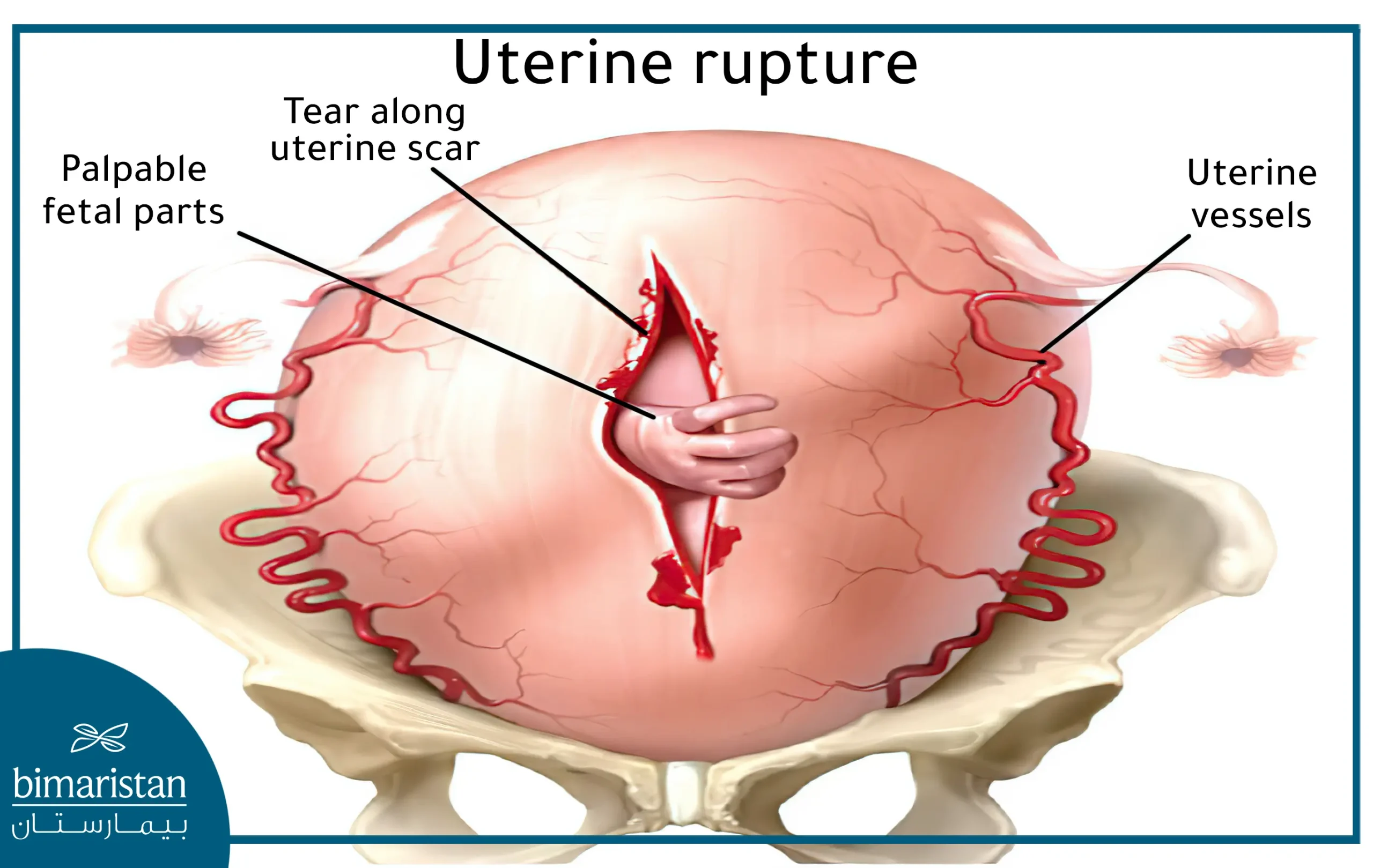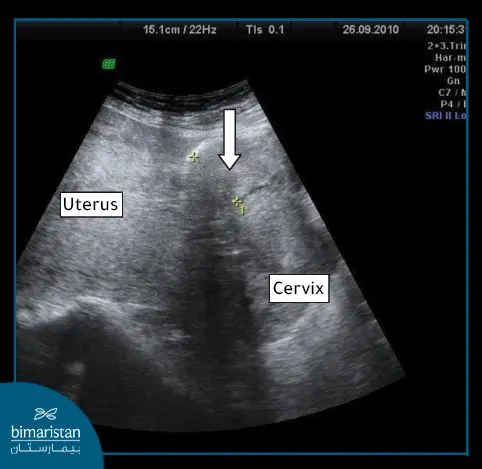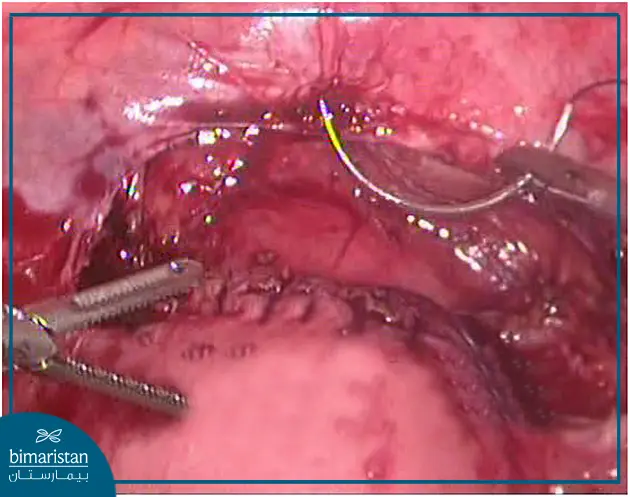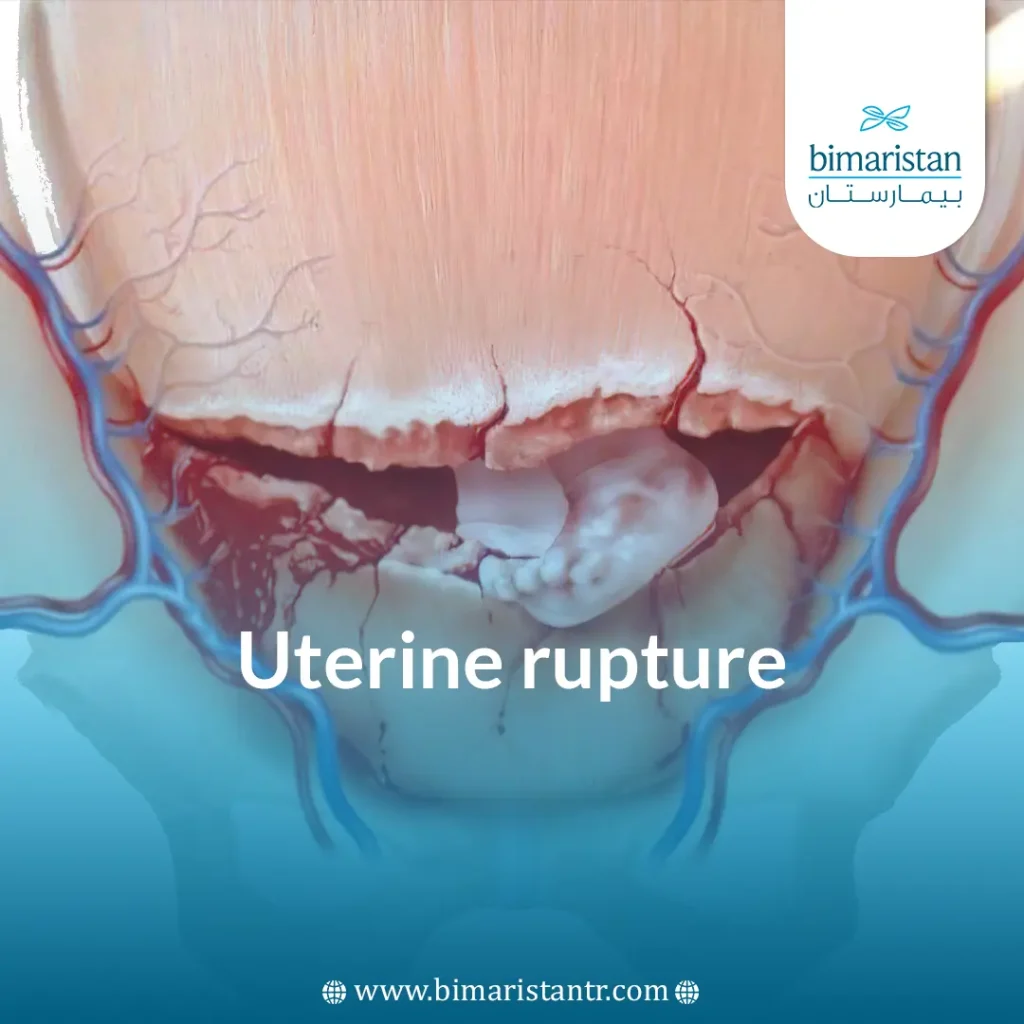Uterine rupture during pregnancy is a life-threatening emergency for both the mother and the fetus. Therefore, prompt and precise intervention is essential.
Uterine rupture is a rare and serious condition where there is complete separation of all layers of the uterine muscle, leading to the partial or complete expulsion of the fetus from the uterine cavity. This can occur due to various reasons, including complicated natural childbirth, surgical abortion, or even severe uterine trauma.
Uterine rupture can result in severe and life-threatening bleeding. If not medically intervened quickly, the condition can be fatal. In Turkey, uterine rupture is treated through immediate surgical procedures to repair the rupture and stop the bleeding. In severe cases, a hysterectomy (removal of the uterus) may be necessary to preserve the life of the patient. Follow along in this scientific article to find everything you need to know about uterine rupture, its causes, and symptoms.
Types of Uterine Rupture
Uterine ruptures are categorized into several types that should be distinguished due to the differing symptoms associated with each. However, there are two main types of uterine rupture:
- Partial Uterine Ruptures: Varying in length and depth, this type of rupture may result in mild to moderate bleeding and moderate pain.
- Complete Uterine Ruptures: Typically causing severe bleeding and acute pain, this type may require immediate surgical intervention to repair the rupture or remove the uterus.
There are also other forms of uterine wall ruptures, such as uterine rupture after cesarean section, which may require different treatment approaches based on the woman’s condition and health circumstances.
Causes of Ruptured Uterus
While uterine rupture can occur spontaneously in some cases, it often happens when there is a tear in the uterine lining due to increased pressure within the uterine cavity. This is frequently associated with pregnancy, and some of the primary causes include:
- Difficult Natural Childbirth: Uterine tear may occur during challenging natural childbirth due to prolonged and excessive pressure inside the uterine cavity.
- Breech Birth: External breech presentation, where the baby’s buttocks or feet come first, is a leading cause of uterine rupture in infants.
- Surgical Procedures: Ruptures may occur during surgical procedures on the uterus or adjacent pelvic organs.
- Previous Scar on the uterus: Scars from previous uterine surgeries, such as cesarean sections or fibroid removal, can lead to uterine dehiscence.
- Uterine Infections: Infections affecting the uterus, such as postpartum infections, can result in uterine wall ruptures.
- Tumors: Certain uterine tumors, especially endometrial cancer and fibroids, can increase the risk of uterine rupture.
- Excessive Use of Oxytocin: Overuse of oxytocin, a hormone that induces and strengthens contractions, is a significant cause of uterine ruptures during childbirth.
- Fetal Malformations: Malformations in the fetus, such as breech or transverse presentations, can contribute to uterine ruptures.
- Disproportion Between Pelvic Size and Fetal Size: When there is a mismatch between the size of the mother’s pelvis and the baby, uterine rupture risk increases.
In summary, uterine tear is a serious condition that demands immediate medical attention, particularly during pregnancy and childbirth. Understanding its types, causes, and symptoms is crucial for timely intervention and optimal patient outcomes.
Signs and Symptoms of Ruptured Uterus
Symptoms and signs of uterine rupture are typically nonspecific; however, rupture generally presents with sudden, severe abdominal pain. Upon examination of the patient, the doctor may observe the following signs:
- Fetal heart rate abnormalities: This is one of the most clinically evident signs of this condition.
- Fetal distress is common, and it may result in fetal demise or long-term neurological injury in some cases.
- Abnormal abdominal shape: Two masses may be visible in the case of uterine rupture during pregnancy (the uterine and placental mass and the fetal mass).
- The fetal head may retract upward during a pelvic examination, and palpating the fetus becomes easier when examining the abdomen.
- Vaginal bleeding may occur, and although it can be internal, a large amount of bleeding can lead to shock, characterized by low blood pressure, rapid breathing, and an increased heart rate.

Diagnosis of Uterine Rupture
The diagnosis of uterine rupture in Turkey usually involves a comprehensive assessment of the patient. The diagnostic steps include:
- Inquiry about the patient’s symptoms, medical history, and medications.
- Physical examination of the affected woman, including examination of the abdomen and pelvis, including the uterus.
- Blood group analysis, complete blood count, and a comparison with previous values to determine the amount of blood loss.
- Clotting status should also be evaluated through clotting tests.
- Imaging studies such as ultrasound (echo) or computed tomography (CT) may be used to identify any uterine tear.
- A small illuminated scope, known as a hysteroscope, may be used by doctors in Turkey to examine the uterus from the inside and closely diagnose any rupture. Generally, hysteroscopy is rarely used for diagnostic purposes.

Treatment for Uterine Rupture in Turkey
Ruptured uterus treatment in Turkey depends on the size and location of the tear, along with other factors such as the patient’s age and her desire for future pregnancies. Simple and moderate tears usually require a period of rest to allow the uterus to heal. The doctor may prescribe some pain-relieving medications to control severe pain resulting from the rupture.
For severe and bleeding uterine ruptures, emergency intervention is necessary to save the patient. In most cases, an open surgery is performed to completely remove the uterus (hysterectomy). However, in some cases, especially if the patient wishes to preserve the uterus for future childbearing, surgical intervention may involve repairing the uterine tear only.
If the uterine tear is not severe, a more planned approach can be taken. Repairing the torn uterus through minimally invasive techniques preserves the patient’s appearance after the operation and reduces her hospital stay. This is achieved through laparoscopic surgery in Turkey, where doctors use diagnostic tools such as hysteroscopes to diagnose and treat the tear simultaneously.

Complications of Uterine Rupture
Severe uterine rupture is considered a serious condition, as any delay in treatment may pose a high risk to the lives of both the mother and the fetus. The primary risk for the mother is bleeding and shock, but the maternal mortality rate after uterine tears does not exceed 1% in Turkey. For the fetus, the mortality rate can reach 30% or more, especially if the uterine tear occurs early in pregnancy before the fetal lungs are mature.
Bimaristan Medical Center remains your first choice for treatment in Turkey, given the availability of advanced medical equipment and our collaboration with experienced doctors in all medical specialties. Feel free to contact us to develop a suitable treatment plan for your condition.
In conclusion, it is crucial to diagnose uterine rupture early and immediately refer the patient to the hospital for necessary treatment. Early diagnosis and prompt treatment are essential to preserve the patient’s life and avoid serious complications.
Frequently Asked Questions About Uterine Rupture
Does uterine rupture cause bleeding?
Yes, uterine rupture can cause bleeding, especially in cases of severe injury. The bleeding can be external (through the vaginal opening) or concealed (inside the abdominal cavity).
How do I know if I have a uterine rupture?
There are no specific signs of uterine rupture, but the tearing of the peritoneum resulting from internal bleeding can lead to severe abdominal pain. This pain will prompt the doctor to conduct further examinations and detect uterine rupture.
What are the symptoms of uterine rupture post-cesarean section?
After a cesarean section, symptoms of uterine rupture may include severe bleeding, acute pain in the pelvic area, low blood pressure, elevated respiratory rate and heart rate, and swelling in the abdominal area. If you experience any of these symptoms after a cesarean section, you should contact your doctor immediately for assessment and appropriate treatment.
Does uterine rupture prevent pregnancy?
Yes, in many cases, it can be challenging to conceive after uterine rupture. This depends on the degree of the tear and its impact on the uterus’s ability to support and nourish the fetus. In some cases, damage can be repaired through surgery to avoid affecting future pregnancies.
When can pregnancy occur after uterine rupture?
In some cases, uterine rupture may lead to deformities that make pregnancy difficult, and in other cases, it may result in partial or complete infertility. Therefore, women should consult their doctors about the impact of uterine rupture on their ability to conceive and the necessary steps to take for successful reproduction.
Can uterine rupture occur without pregnancy?
Yes, uterine rupture can occur without pregnancy due to sharp injuries, accidents, or previous surgical procedures on the uterus. It may also occur as a result of certain diseases, such as fibroids, which increase pressure within the uterine cavity, making it more susceptible to rupture.
When does uterine rupture heal?
The healing process of uterine rupture depends on various factors, including the size and location of the tear and the treatment provided. Healing can occur quickly (within a few weeks) in some cases, while in others, it may take a longer time.
Sources:
- NHS Wales
- European Journal of Obstetrics and Gynecology
- PLOS
